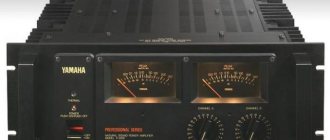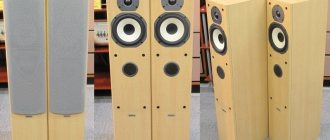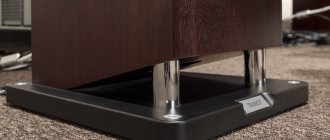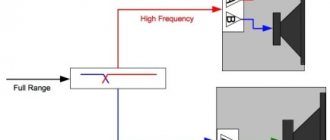A year and a half ago, the announcement of Yamaha’s flagship “five thousandth” series caused a lot of noise in the audiophile community. The only speakers presented at that time were impressive three-way speakers that combined nostalgic design with high-end technical solutions. And only now shelf holders are coming onto the scene - compact, but no less radical in terms of technology and materials.
In the course of the story about the new bookshelf speakers, the older NS-5000 speakers will have to be mentioned more than once. Firstly, their appearance became a kind of manifesto - a loud statement that the famous company had decided to revive the production of very serious home acoustics. Secondly, many advanced design solutions implemented in the “five thousandth” models logically migrated to our test subjects.
An absolute rarity - an advertisement for other Yamaha NS-3000 speakers, developed many years ago, but never put into mass production
However, externally the NS-3000 looks much less radical. The older speakers are large, wide cabinets on a low stand - it seems as if they came straight out of the pages of hi-fi catalogs from the 70s of the last century. Well, before us are classic bookshelf speakers, the layout of which is universal and unshakable, like the staff itself.
Your Honor
However, half-timers are different from half-timers. It would seem that the “piano lacquer” design is not used today only by the lazy, but in our case the quality of the finish is simply defiantly perfect. It’s hard to feel from the photo, but you get the feeling that you really were next to a concert grand piano in the conservatory hall. The very idea of touching your fingers to the noble gloss created by many layers of real varnish seems simply blasphemous.
And not even because it is very expensive, but simply since you are not a creator, then the instrument is not your work. The famous logo inlaid with metal only emphasizes the associations. By the way, the NS-3000 and NS-5000 are the only home speakers that feature the Yamaha nameplate at the top of the front panel.
The degree of sublime concert pathos is slightly reduced by the aluminum flanges that secure the speakers. Their deliberately rough matte polishing saves them from an excess of gloss and harmonizes perfectly with two silver diffusers of a very non-trivial design.
The rear panel is designed no less stylishly and solidly
But before we move on to discussing the drivers, let's take a look at the rear panel. Here we found a bass reflex port, whose cunning star-shaped shape is designed to combat turbulent overtones, as well as one pair of luxurious terminals. Their massive polished nuts are milled from solid brass and are identical to both the NS-5000 and the new high-end M-5000 clamps.
Let's sum it up
Yamaha's junior flagships, the wonderful NS-3000 speakers, can easily compete with their older brothers in a number of positions. They have a more universal look - they will not become outdated, even if fashion trends change. They are not much inferior to them in sound quality, but they are perhaps superior in integrity and consistency - two bands are easier to integrate than three. And finally, their price is about half as much. So they are worthy of the most sincere recommendations to those who are assembling a top-class system for working in a small room.
All equipment was tested in Audiomania showrooms How we test Hi-Fi components
March 2022
This review has been read 4,277 times.
The armor is strong
Both Yamaha NS-3000 speakers received diffusers made of Zylon polymer. This material was developed in the 80s and has since managed to displace Kevlar in many of its original applications - from the production of body armor to astronautics. Which is not surprising, because its tensile strength is 1.6 times higher.
But in our case, it is much more important that the elastic modulus of zylon reaches 270 GPa. For comparison: aluminum has 69, steel has 200, and beryllium has 287. That is, with a much lower specific gravity, it allows you to achieve an extremely low level of parasitic deformations of the dynamic head membrane.
The rubber suspension is clearly designed for a fair amount of diffuser travel
But the miracle polymer also has its own Achilles heel - it is not resistant to ultraviolet radiation. For this reason, as well as to optimize flexural characteristics, Yamaha engineers decided to cover the cones with a copper-nickel alloy, Monel, which is applied to a Zylon “canvas” using a vacuum deposition method. By the way, the strength and chemical neutrality of Monel are such that minesweeper cables and valves for high-quality brass instruments are made from it.
The developers especially emphasize that the choice of the same material for the diffusers of all heads made it possible to achieve high timbral uniformity over the entire frequency range. Of course, our test subjects inherited the Zylon diffuser technology from the flagship model.
Sound waves enter the rear chamber in different ways to meet there in antiphase and subside
The rigidity of cast baskets with additional ribs is beyond doubt
Moreover, the tweeter in the “three thousand” is the same as in the NS-5000. Behind its 3 cm diaphragm there is a channel leading to an acoustic chamber of complex shape. In it, reverse sound waves, usually reflected from a magnetic core and blurring the phase structure of the main radiation, fade away without a trace.
The interface between the tweeter and the 16 cm mid/bass driver is located at a frequency of 2.8 kHz, and the filter uses components from the well-known Mundorf - in particular, MCap SUPREME EVO capacitors.
As for the office, it, apparently, was also built in the image and likeness of the “five thousandths”. That is, the walls are made of Japanese white birch plywood from the island of Hokkaido, and the physical parameters of the box are calculated by the finite element method and then tested using laser interferometry.
In addition to the stiffeners, an acoustic absorber is installed inside the column, which is a U-shaped tube/waveguide partially filled with fibrous material. This move allows, on the one hand, to effectively combat internal standing waves, and on the other, to get rid of the excess volume of damping mats in the body, and therefore from unnecessary losses in bass dynamics.
First height
Our test configuration was made up of a Plinius Kaitaki preamplifier and a Plinius P10 amplifier, as well as a Technics SL-G700 network and SACD player. So the setup turned out to be, although not completely Japanese, but, so to speak, Pacific Island.
The P10 power supply is capable of delivering 200 W per channel into an 8-Ohm load at an output slew rate of 50 V/ms. At the same time, the maximum recommended power of the Yamaha NS-3000 is 120 W (6 Ohms).
The speakers were installed on SPS-3000 supports designed specifically for them. These are impressive 15kg racks with an MDF bottom plate and a 6mm steel top plate. It’s nice that for reliable fixation it has a pair of holes corresponding to the cage nuts on the bottom surface of the speaker.
The design turned out to be rigid, durable and very respectable in appearance, but the height (64.8 cm with spikes) seemed a little low to me for the average European music lover. In any case, with a height of 173 cm, sitting in a regular chair, I wanted the tweeters to be 5–7 centimeters higher.
Although this discomfort was largely visual: the impressive dispersion (both horizontal and vertical) allows freedom in positioning. A more radical move is to place the racks on stone anti-resonance slabs.
According to unofficial data, rubber granules have been added to the material of the lower support plate for additional damping
The average impedance of the Yamaha NS-3000 is 6 Ohms with a minimum of 4.6 Ohms, sensitivity is 87 dB/2.3 V/1 m. As for the frequency range, it is designated quite specifically: 39 Hz - 60 kHz with unevenness -10 dB .
I did not have the opportunity to conduct my own reliable measurements (i.e. in an anechoic chamber, with microphones of the appropriate class, etc.), so the bass talents of the “three thousandth” will have to be judged solely by subjective sensations.
As for HF, their ceiling is clearly limited by the capabilities of human hearing. You didn’t have to listen particularly closely to be convinced of this. However, first things first.
There is speed
It has been so long since Yamaha has spoiled music lovers with truly high-class acoustics that today in the public consciousness the brand is associated primarily with home theater equipment. This is a high-quality equipment with an enviable ratio of capabilities, parameters and price, but it is quite far from connoisseurs of serious sound. Although experienced audiophiles, like professionals, remember both the legendary NS-10 studio monitors and the very worthy SOAVO home line.
Turning on the NS-3000, you immediately remember the very sound that Yamaha encrypted decades ago in the abbreviation NS, that is, Natural Sound. In his current incarnation, he turned out to be light, transparent and extremely fast.
Many music lovers have a general idea of the “Yamaha” sound - and the “three thousandths” clearly follow the established musical philosophy. But on the other hand, almost all family qualities here are taken to a fundamentally higher level.
First about the top of the range. I couldn’t deny myself the pleasure of opening the audition with chamber jazz, because the piano and brass instruments for Yamaha are literally the closest and dearest instruments.
For starters, “Midnight Sugar” is a SACD album by the trio Tsouyoshi Yamamoto. Despite the laconicism of the music scene, it seems to be literally permeated with sparks, scattered plates, and therefore unexpectedly voluminous and wide. Tsuyoshi Yamamoto's keys are almost tactile; on strong notes, light string overtones and aftertones can be clearly heard.
Next comes jazz of a completely different vintage and flavor. John Coltrane's lost album, Both Directions at Once, was recorded in 1963 on quarter-inch mono tapes. And then the sources waited in the wings for several decades before they were directly digitized and mixed in 24 bit/192 kHz format.
The NS-3000 presented the recording as an amazing mixture of vintageness with its usually unusual live microdynamics and a coherent, again absolutely tangible sound texture.
Looking ahead a little, I will say that the speakers turned out to be capable of revealing multi-layered mixes of any complexity without any problems. Moreover, somehow they manage not to dry out or dismember the unified musical fabric.
The asymmetrical bass reflex bell is not only beautiful in appearance, but also effectively suppresses turbulent overtones
I confess that I chose the two above-mentioned albums not least because of their dense, richly articulated and generously written acoustic bass. And the acoustics there also made me remember the subtleties of the signature style.
Everyone is aware that recently the public prefers thicker and heavier bass. But the NS-3000 is not inclined to pander to mass fashion. They don't try to look like mighty towers, and they certainly don't try to look like a boombox.
However, within the available volume and acoustic design, the low-frequency base here is worked out with no less care than other parts of the spectrum. Midbass is quite solid, energetic and very detailed.
This pattern, in my opinion, extends to approximately the 50–60 Hz mark. It’s unlikely to find fault with the relief and tonal intelligibility of the double bass in this section. And, judging by the particular depth of the sound in the region of 80–90 Hz, the bass reflex is tuned precisely to this frequency.
In fact, the connectors are much larger than it might seem from the photo
As for the vocal section, in terms of exhaustive detail, dynamics and microdynamics it is, perhaps, in no way inferior to the treble. On the DSD releases of Emilie-Claire Barlow, Emily's voice was not just deep or rich in overtones.
It turned out to be light, bright, cheerful and at the same time left no doubt about the audiophile accuracy of the transmission of all tonal components, including distinct sibilants. What is characteristic is that they did not seem harsh or artificially accentuated at all.
Perhaps the point here is that the level of the vocal range, especially in its upper part, is barely noticeably inferior to the higher frequencies. But just enough so as not to add to the exquisite vocalist an overcooked expression that is not typical for him.
Yamaha A-S3000 Black Gloss
The Yamaha A-S3000 integrated amplifier features a new high-strength dual-structure design for extremely clear and precise audio amplification. The underbody and shock absorbers dissipate and absorb external vibration. Each board is designed using a floating design and is supported by an individual frame, which further eliminates vibration. The power supply unit, consisting of a power transformer and capacitors, which are the main sources of internal vibration, is securely mounted on a three-dimensional structured frame and firmly supported by the front and rear panels. The amplifier circuit board and heavy heatsinks are mounted on the left and right inner frames. Thus, the power supply and amplifier boards are separated from each other, and the well-thought-out design reliably absorbs vibration. Under the frame on which the transformer is mounted, free space is provided for laying wires to the circuits along the shortest path. This innovative chassis design minimizes the signal path and achieves low impedance, while also providing high rigidity and anti-vibration properties. The result is significantly reduced signal loss, and the amplified sound is exceptionally clear.
The Yamaha A-S3000's insulated 3D internal frame provides a strong support for the large toroidal transformer, which is mounted in the center of the S3000 for ideal weight distribution. The copper-plated internal frame is a load-bearing structure that rigidly bridges the front/rear and side frames, reducing vibration in all directions. For the manufacture of the support on which the transformer is mounted, after a comprehensive analysis of the sound properties of various materials (including the use of listening sessions), brass was chosen. This material effectively reduces vibration transmitted from the transformer, helping to create clearer, more transparent sound. To achieve a signal of absolute purity, conveying all the nuances and dynamism of music, for example, when reproducing powerful low frequencies or the emotion of the human voice, we aimed to reduce impedance throughout the Yamaha A-S3000 circuit. The double design provides free space under the support frames, which is necessary for laying the power cables from the transformer to the final stage along the shortest path, as well as wires for transmitting the audio signal. This helps eliminate signal transmission losses, improve power stability even under high-power pulses, and result in improved playback. The three-dimensional internal frame that supports the transformer is copper-plated. Reducing the ground potential provides extremely low impedance. Thanks to this, the noise level is sharply reduced and a rich emotional sound is achieved that fully conveys the performer’s expression.
The top and front panels of the Yamaha A-S3000 amplifier are made of non-magnetic material - aluminum in order to eliminate any adverse effect on the audio signal.
After a comprehensive analysis of the sound quality, it was decided to determine the thickness of the front panel to be 7 mm, and for the top - 6 mm. Thanks to the high degree of rigidity of the structure and effective vibration suppression, the sound is more natural and spacious. The ventilation holes on the top panel are precision cut with the utmost attention to detail. Stylish slots, like those on the CD-S3000, are designed to dissipate heat from the power supply, and match the size of the transformer installed inside. The Yamaha A-S3000 is designed with independent preamplifier and power amplifier units and a perfectly symmetrical circuit layout on the left and right sides of the interior. Separating the preamplifier, which deals with low-power signals, from the power amplifier, which deals with high-voltage signals, greatly reduces the level of noise in the audio caused by mutual interference. In addition, the symmetrical design of the left and right sections, which are completely isolated from each other, provides better channel separation and enhances the clarity of stereo images.
The design of the Yamaha A-S3000 is based on proprietary technology of a potential-free symmetrical power amplifier. The use of output elements with the same polarity on the positive and negative sides of the output stage, as well as the separation of the negative feedback circuits (NFC) and the power supply in a total of four positive and negative poles of the left and right channels ensures symmetrical push-pull operation of the output stage. Complete isolation of the power amplifier from ground eliminates all negative consequences from the slightest voltage deviations or noise on the ground bus. In addition, the output elements include MOSFETs, which provide warm and natural sound. The use of equally distributed polarity MOSFETs furthers the idea of a fully symmetrical design to eliminate variations in audio signal quality due to differences in polarity, which is the main feature of a potential-free symmetrical power amplifier. The result is sound with excellent signal-to-noise ratio and a clearly defined sound field.
The Yamaha A-S3000 amplifier provides fully symmetrical signal transmission.
In addition, the control circuits (volume, timbre, etc.) of the preamplifier function absolutely symmetrically, thereby realizing the idea of perfect symmetry in all stages. The power transformer wiring uses an ingenious technique to significantly reduce the impedance. Unlike a conventional circuit, the transformer winding is attached to the terminals with screws. This allows you to significantly reduce the energy losses that occur when connecting using soldering. The toroidal transformer was chosen to ensure stable power supply, which helps achieve a more natural and spacious sound.
To completely eliminate signal energy loss, critical components are threaded, even on printed circuit boards. In addition to the wiring connections for the block capacitors in the power supply, which is the heart of the amplifier and requires high voltage, screw connections are used at all key signal transfer points, including where the preamp circuitry connects to the power amplifier. Wires also go from the output stage of the power amplifier to the speaker terminals. In addition to significantly shortening the signal path, this can significantly reduce impedance and reduce signal loss.
The high-quality digital volume ladder control used in the Yamaha A-S3000 was specially developed by New Japan Radio Co., Ltd. It prevents uneven rate of voltage rise (sound coloration) from affecting the signal, resulting in cleaner sound and faster response to sudden dynamics and pulsed sounds.
The turntable amplification circuit consists of an MC preamplifier and a frequency equalizer amplifier, each of which is discretely configured to produce rich, musical sound when playing vinyl records on turntables with both MC (moving coil) and MM pickup types. (with moving magnet).
The Yamaha A-S3000 features large front-panel level meters for a direct visual display of the dynamics and pulse of the music. Soft LED lighting creates a feeling of warmth and comfort. In addition to the standard voltage level (VU) display, the indicators can show peaks. The user can choose the desired mode himself. The indicator window is covered with beveled glass that attaches to the inside of the front panel without the use of screws. This gives the device an extremely elegant look.
As befits high-end audio equipment, the Yamaha A-S3000 looks like a musical instrument: a clean, smooth surface, no screws visible. Every aspect of the construction and design reflects the high level of craftsmanship and commitment to quality inherent in Yamaha products, the world's leading manufacturer of musical instruments and equipment. The amplifier cabinet uses advanced processing technology, including the integration of the top panel and side wood panels without gaps.
The speaker terminals, the final link in this amplifier's audio signal chain, are also crafted with the utmost care and attention to detail. The original screw terminals with large heads are machined from brass and provide a reliable connection without loss of sound quality. Not only do they look elegant, they are shaped to grip perfectly and require minimal effort to tighten.
Since the user's hands are constantly touching knobs and switches, we strived to make them pleasant to the touch, paying close attention to design and texture.
The volume knobs, input selector, and other controls, machined from aluminum, literally exude a feeling of elegance and luxury. The toggle switches are made with the utmost attention to detail and texture: the precision with which these elements are made eliminates the formation of a gap with the surface of the panel in any position of the toggle switch - up or down. The included remote control is made in the same style as the amplifier's aluminum panel - simple design, intuitive button layout, pleasant metal texture. The remote control not only allows you to adjust the volume and switch inputs on the Yamaha A-S3000 amplifier, but can also be used to control the CD-S3000 CD player.
Review of the Yamaha A-S3000 integrated amplifier and Yamaha CD-S3000 CD player from the SalonAV portal
Yamaha continues to expand its hi-fi lineup. This means that consumer interest in good home music playback equipment continues unabated. The new “three thousandth” series, which has actually become the flagship, returns us to the traditions laid down by audio.
They say first impressions can be deceiving, but this is unlikely to be the case now. Yamaha's new top models look incredibly solid. Both the player and the amplifier of the “three thousandth” series are made in the same design and form factor, each has a reinforced chassis, wooden side panels, thick top covers in which ventilation slots are milled. The design is a sort of neoclassical Hi-Fi. Lots of knobs, buttons, toggle switches... The facade of the amplifier is even decorated with dial indicators with switchable operating modes - VU and PEAK. And all this does not look old-fashioned, but very fresh and attractive.
The housings of the new components are not as simple as they seem.
They are divided internally into different levels and sections by power struts in order, on the one hand, to eliminate the influence of electromagnetic interference from some electronic parts on others, and on the other, to provide proper mechanical protection from vibrations. The layout diagram of the integrated circuit seems to be turned backwards. A giant toroidal transformer is installed almost behind the front panel, on the sides of it there are ends with powerful radiators, and the rear compartment is allocated to a bank of four large buffer tanks. The preliminary section is fixed directly to the rear wall, at the input and output sockets. The latter on the A-S3000 are represented not only by linear terminals for four sources, but also by a phono input plus a pair of balanced jacks, moreover, with switchable sensitivity. A thoughtful arrangement of blocks allows you to shorten the path of the music signal and at the same time organize almost direct power circuits, avoiding even insignificant energy losses in them.
The Yamaha CD-S3000 player is also interesting in terms of design.
Its power system is divided into two parts (each with its own transformer), which are physically separated from each other and located in the corners immediately behind the front panel. Even the support legs of the new components are not simple - they can be supplemented with the included spikes or elastic shock-absorbing pads. The integrated circuit design is notable for its fully balanced topology. The signal along all links of the path - the volume control unit (by the way, in the A-S3000 it is audiophile, ladder type, i.e. without loss of quality), tone unit, intermediate and final amplification - is transmitted in differential form. The output stage on field-effect transistors is also made according to a symmetrical bridge circuit. By the way, this must be taken into account when connecting speakers - none of the speaker terminals are connected to the ground of the amplifier.
The Yamaha CD-S3000 player is equipped with a high-speed reading mechanism of its own design with a chic aluminum loader, the drive of which is completely silent. At the factory, this assembly is carefully aligned and balanced after installation on the player chassis. The digital path is expanded with a USB input, which also supports the ASIO 2.3 protocol for professional work with computer audio. The converter is the best 32-bit processor from the ESS Technology line - an eight-channel 9018 chip, capable of working with a single-bit DSD data stream when playing SACD. However, the “multi-DAC” nature of this processor does not imply multi-channel audio output. Only a stereo signal is supplied to the output - either in standard linear form or in balanced form. The analog section following the DAC is implemented using single-stage discrete circuits that convert current into voltage.
Among the important functional features of the Yamaha A-S3000, I note the presence of an speaker selector, a four-position sensitivity trimmer for the telephone output, and a cartridge type switch for the phono stage.
There is no button to turn off the tone block, but the function itself is there - this cascade automatically switches to linear bypass mode when the tone controls are set to a fixed middle position. The player, in addition to the mandatory SACD layer selection function, has a digital input selector (USB, Coax, TOSlink) and a single-mode Pure Direct. When activated, the display turns off and the digital inputs are muted - all potential sources of interference. I conducted the audition using the “substitution” method, when new components are successively replaced by other blocks in an already established reference system. So, first, instead of the Bryston BCD-100 player, I turned on the CD-S3000, and the Japanese device took up the baton with dignity. The Yamaha player does not sound as sharp and dynamic in comparison to the “Canadian”, but in all other respects it is superior to it. You can feel an increase in the plasticity of the sound, the timbres are even cleaner and richer, but not at all overplayed, the detail is generally beyond praise. But what is most captivating is the ability of the CD-S3000 to form very accurate and physical images in a spatial scene. Such a sound - albeit calm in temperament, but sleek, confident and endlessly elaborate - can be listened to for hours.
I'm making another replacement - switching all components from Bryston to Yamaha A-S3000.
The first impression is not the most pleasant. After the dense and firmly delivered sound of the “Canadian”, the sound signature of the Yamaha amplifier is perceived as dry, stingy with colors and even aggressive, although there is no hint of transistor harshness. But after just five to ten minutes, the A-S3000 completely captured my attention. This is a really super informative amplifier! He unleashes a barrage of details and some completely elusive details. But this flow does not disorient or distract, but complements the musical picture and makes it clearer. And the manner of transmitting trebles is actually not aggressive at all, but rather sharp, without the slightest blurring, which is why the upper range is sounded without any coloration and completely impartially, like the best High End amplifiers. However, in any lane, the Yamaha A-S3000 shows signs of a high class. The bass is controlled almost ironclad. The attack is clean and full, the low end is not stretched out or simplified. Midbass is dense, abrupt, but not violent. The middle is completely open from the bottom to the top. It may seem that there is not too much musical plasticity in this range, but in fact the amplifier simply does not add anything of its own to the sound - how an instrument or voice sounds in the original is how it gives them out. When all the basic parameters are in order, then the scene does not present surprises - the A-S3000's space is well focused, large-scale and clearly planned.
Switching to a balanced connection in a “player-amplifier” pair gives even clearer and faster dynamic sound, but at the same time it is less accurate in the high frequencies. The detail, which already seems obscenely frank, becomes completely prohibitive. I try to turn on Pure Direct - there is a slight cleansing effect, but it does not add harmony. I try to listen to SACD and again I am amazed at the ability of Yamaha components to concentrate on the smallest nuances. This suggests an analogy with optical instruments - with a microscope or telescope. The sound only becomes more flexible when I return to the linear connection again. But this should be explained by the fact that the interconnect cables here are of a much higher class. I will also note that the balanced connection turned out to be better in all respects when I connected systems with soft-dome tweeters instead of our reference acoustics.
I won’t go into detail about how the player sounds in USB DAC mode, otherwise I’ll have to repeat myself.
When matched with a computer at the same frequencies in which the audio files themselves are recorded (for example, 44.1 kHz for standard uncompressed WAV rips, 96 or 192 kHz for 24-bit studio FLAC), the result is playback that is close in nature to the original playback CD or SACD. In general, the feeling of originality, of touching something genuine, does not leave you while you listen to music on these components. I sincerely say: Yamaha surprised me.
Characteristics of Yamaha A-S3000
Min. power (4 ohms, 1 kHz, 0.7% THD, for Europe) 170 W + 170 W High dynamic power / channel (8/6/4/2 ohms) 120/150/200/300 W Damping factor 250 Reproducible range Frequency 5 Hz-100 kHz (+0 dB/-3 dB) RIAA Equalization Deviation 20 Hz-20 kHz +/-0.5 dB Total Harmonic Distortion (CD to speaker output, 20 Hz - 20 kHz, CD) 0.025% Ratio signal to noise (CD) 103 dB (S: 200 mV) Input sensitivity (CD) 200 mV/47 kOhm Dimensions (WxHxD) 435 x 180 x 464 mm Weight 24.6 kg










